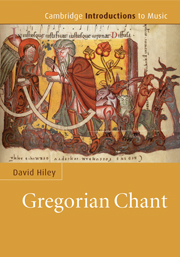Book contents
- Frontmatter
- Contents
- List of illustrations
- List of musical examples
- Note on the musical examples
- List of tables
- List of text boxes
- Preface
- Note on front cover illustration
- Chapter 1 Gregorian chant in the service of the church
- Chapter 2 The beginnings of Gregorian chant; other rites and other sorts of chant
- Chapter 3 Tradition and innovation in medieval chant: from the ninth to the sixteenth century
- Chapter 4 Thinking about Gregorian chant in the Middle Ages, and notating it
- Chapter 5 New chants for new times: from the sixteenth century to the present; aspects of performance
- Map of places from which important medieval chant manuscripts are preserved
- Chronological table
- Statistical table of chant categories by mode
- Original manuscript sources for musical examples
- Glossary
- Bibliography
- Index
Chapter 4 - Thinking about Gregorian chant in the Middle Ages, and notating it
Published online by Cambridge University Press: 05 October 2014
- Frontmatter
- Contents
- List of illustrations
- List of musical examples
- Note on the musical examples
- List of tables
- List of text boxes
- Preface
- Note on front cover illustration
- Chapter 1 Gregorian chant in the service of the church
- Chapter 2 The beginnings of Gregorian chant; other rites and other sorts of chant
- Chapter 3 Tradition and innovation in medieval chant: from the ninth to the sixteenth century
- Chapter 4 Thinking about Gregorian chant in the Middle Ages, and notating it
- Chapter 5 New chants for new times: from the sixteenth century to the present; aspects of performance
- Map of places from which important medieval chant manuscripts are preserved
- Chronological table
- Statistical table of chant categories by mode
- Original manuscript sources for musical examples
- Glossary
- Bibliography
- Index
Summary
The revival of learning under Charlemagne and his successors brought with it knowledge of the music theory of late antiquity and consequently a desire to relate Gregorian chant to that theory. Section 4.i explains what happened. An important element of the theory was the notion that the whole of creation was ordered according to harmonic principles. At the end of Chapter 3, it was suggested that some of the new chant composed in the eleventh century might have been inspired by a desire to reflect this harmony of the universe in newly composed melody, as it were composition according to theoretical principles. This idea is briefly considered in section 4.ii.
Simultaneously with the assimilation of classical music theory, musical notation was developed, in the form of the signs we call neumes. Musical theory and the notating of chant books were not at first directly linked. Neumes did not indicate precise pitch, and were thus of no use for the description of such matters as musical scales and intervals. But the ninth-century theoretical enterprise included one achievement of crucial importance, the linking of Gregorian chant to the tonal network of classical scale systems. Chant melodies could be imagined as a series of notes placed on the steps of a ladder (Latin scalae means ‘stairs’, hence our ‘scale’), where the pitches at each step and the intervals between them were precisely defined.
Information
- Type
- Chapter
- Information
- Gregorian Chant , pp. 162 - 207Publisher: Cambridge University PressPrint publication year: 2009
